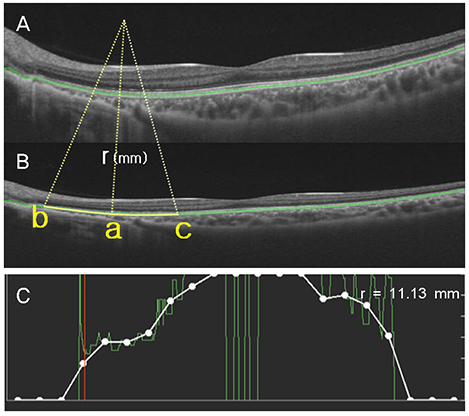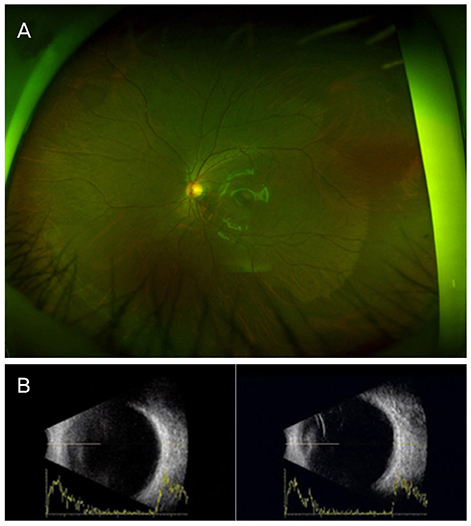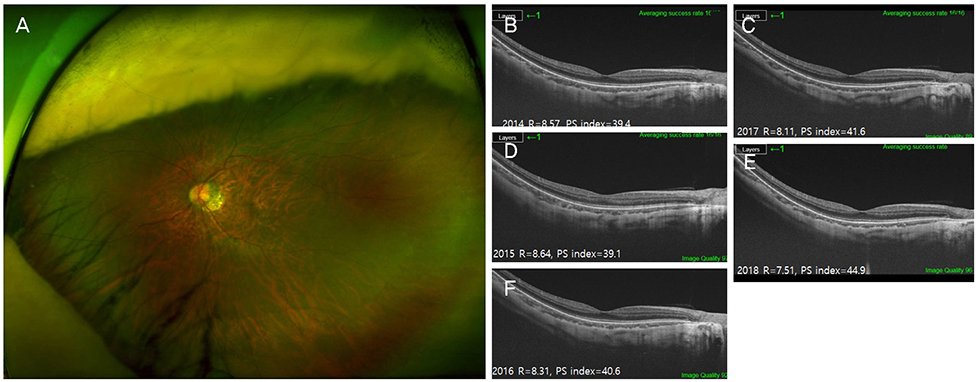J Korean Ophthalmol Soc.
2019 Sep;60(9):867-873. 10.3341/jkos.2019.60.9.867.
The Shortest Radius of Curvature of Bruch's Membrane in Macular Optical Coherence Tomography
- Affiliations
-
- 1Department of Ophthalmology, Pusan National University School of Medicine, Yangsan, Korea. oph97@naver.com
- 2Research Institute, Pusan National University Hospital, Pusan, Korea.
- KMID: 2459131
- DOI: http://doi.org/10.3341/jkos.2019.60.9.867
Abstract
- PURPOSE
To develop software to measure the shortest radius in curvature of Bruch's membrane from optical coherence tomography (OCT), and then to apply it to various types of eyes.
METHODS
Macular OCT images consisting of 12 images of 9 mm radial scans were studied. The horizontal to vertical pixel ratios were changed to 1:1, and Bruch's membrane was marked automatically on each image. Software to measure the radius of Bruch's membrane curvature was developed. The shortest radius on each image was defined as r (mm) and the average r of 12 images was defined as R (mm). The reciprocal of R was multiplied by the constant, 337.5, which was defined as the posterior staphyloma (PS) index.
RESULTS
The OCT images of five eyes were analyzed by the software, which could calculate the curvature of Bruch's membrane automatically. The PS indices were 12.7, 23.7, and 66.4 in eyes without refractive error (Case I), in the high myopic group without posterior staphyloma (Case II), and in the high myopic group with posterior staphyloma (Case V), respectively. The PS index gradually increased according to aging in a 37-year-old patient (Case IV) with mild staphyloma from 34.6 to 39.5 over 4 years.
CONCLUSIONS
PS index is a novel parameter to reflect the level of posterior staphyloma, but further studies are needed to apply it to clinical patients.
MeSH Terms
Figure
Reference
-
1. Ohno-Matsui K, Jonas JB. Posterior staphyloma in pathologic myopia. Prog Retin Eye Res. 2019; 05. https://www.ncbi.nlm.nih.gov/pubmed/30537538. Dec 8, 2018.
Article2. Numa S, Yamashiro K, Wakazono T, et al. Prevalence of posterior staphyloma and factors associated with its shape in the Japanese population. Sci Rep. 2018; 8:4594.
Article3. Ohno-Matsui K. Proposed classification of posterior staphylomas based on analyses of eye shape by three-dimensional magnetic resonance imaging and wide-field fundus imaging. Ophthalmology. 2014; 121:1798–1809.
Article4. Ohno-Matsui K, Alkabes M, Salinas C, et al. Features of posterior staphylomas analyzed in wide-field fundus images in patients with unilateral and bilateral pathologic myopia. Retina. 2017; 37:477–486.
Article5. Miyake M, Yamashiro K, Akagi-Kurashige Y, et al. Analysis of fundus shape in highly myopic eyes by using curvature maps constructed from optical coherence tomography. PLoS One. 2014; 9:e107923.
Article6. Wakazono T, Yamashiro K, Miyake M, et al. Association between eye shape and myopic traction maculopathy in high myopia. Ophthalmology. 2016; 123:919–921.
Article7. Wakazono T, Yamashiro K, Miyake M, et al. Time-course change in eye shape and development of staphyloma in highly myopic eyes. Invest Ophthalmol Vis Sci. 2018; 59:5455–5461.
Article8. Curtin BJ. The posterior staphyloma of pathologic myopia. Trans Am Ophthalmol Soc. 1977; 75:67–86.9. Spaid RF. Staphyloma: Part 1. In : Spaide RF, Ohno-Matsui K, Yannuzzi L, editors. Pathologic Myopia. New York: Springer;2014. chap. 12.10. Hayashi K, Ohno-Matsui K, Shimada N, et al. Long-term pattern of progression of myopic maculopathy: a natural history study. Ophthalmology. 2010; 117:1595–1611. 1611.e1–1611.e4.11. Ohno-Matsui K, Kawasaki R, Jonas JB, et al. International photographic classification and grading system for myopic maculopathy. Am J Ophthalmol. 2015; 159:877–883.e7.
Article12. Ohno-Matsui K, Lai TY, Lai CC, Cheung CM. Updates of pathologic myopia. Prog Retin Eye Res. 2016; 52:156–187.
Article
- Full Text Links
- Actions
-
Cited
- CITED
-
- Close
- Share
- Similar articles
-
- Influence of the Macular Curvature on Foveal Migration after Macular Hole Surgery
- Human Bruch's Membrane: Regional and Age-Related Alterations
- Morphologic and Functional Evaluation before and after Vitrectomy in Idiopathic Epiretinal Membrane Patients Using Microperimetry
- Characterization of Peripapillary Atrophy Using Spectral Domain Optical Coherence Tomography
- Optical Coherence Tomographic Finding in a Case of Macular Coloboma






